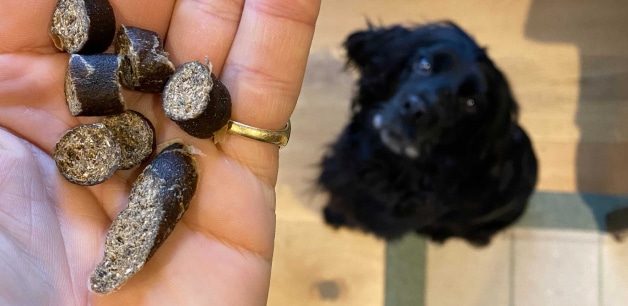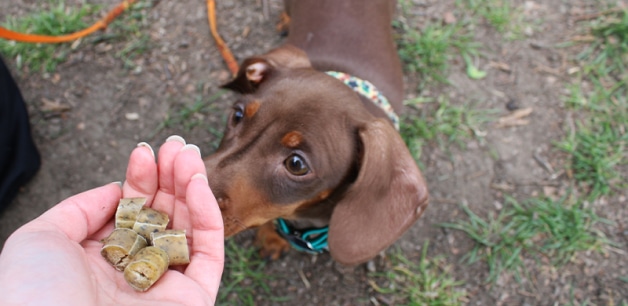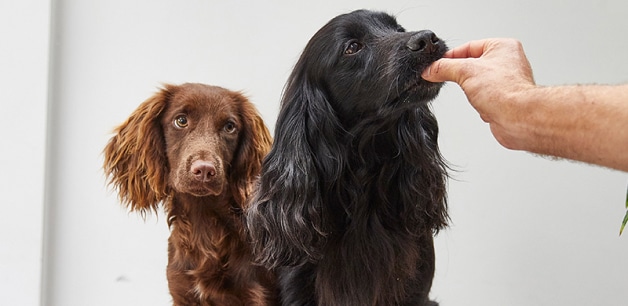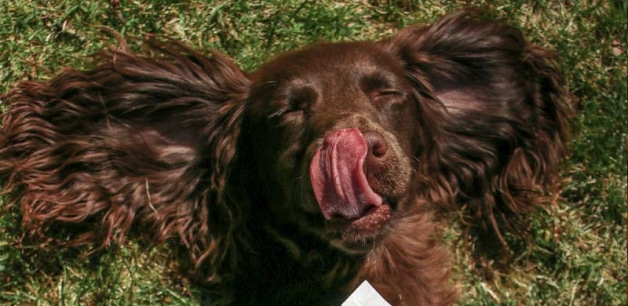A detailed guide on how many treats your dog is allowed to eat
Treats are more than just a tasty snack for your dog; they make an excellent tool for training and reinforcing good behaviour. As a dog owner, I understand how tempting it is to indulge your dog with all the treats they desire. However, there are guidelines to follow when doing so, to ensure you’re not overfeeding or encouraging bad behaviour.
Here’s my advice on giving your puppy or dog treats, whilst keeping things healthy and fun for them!

Navigating the 10% rule
If you’ve not heard of it already, the 10% rule is the best rule to follow when treating your dog. The 10% rule means your dog’s treats per day allowance should take up no more than 10% of their daily calorie intake.
To work this out, it’s useful to know the number of calories you should be feeding your dog per day. These can be provided by your pet food’s manufacturer or found on the back of all dog food packaging. Then, work out the calories per gram of your chosen treats. Make sure that on any given day, you are never feeding treats worth more than 10% of your dog’s overall calorie count.
If you’re unsure of the calories your dog will need a day for a healthy weight, contact your vet for advice. The 10% rule is to prevent overfeeding your dog. You don’t want them to become greedy either!

Factors that influence your dog’s treat allowance
Despite the 10% rule, there are many other elements that play a part when figuring out your dog’s daily portion of treats.
Firstly, is your dog of a healthy weight and body condition for their age and breed? If your dog is overweight, you should speak to your vet about a weight loss plan before considering treat allowances.
The activity level of your dog can make a difference to how many treats they are allowed.
If your dog is considered a high-energy breed and enjoys regular exercise, you can safely feed them up to their 10% treat allowance.
If your dog is overweight or prefers to snooze on the sofa all day, you should be cautious of how often you’re treating them.
If your dog is within their ideal weight range, including their allowance of treats, then you have definitely mastered the perfect balance of treats!
It’s important not to overfeed treats, as it can easily be done. This is really important for fussy dogs too, as they may be less likely to eat their staple diet at meal time. Treats shouldn’t be a replacement for a complete meal, and of course too many treats can contribute to weight gain.
What about puppies?
When you first take a puppy home, you are limited with the treats you can give them. Some pet food manufacturers make treats that are only suitable for puppies aged four months and older. It’s advised to research the best treats for your puppy prior to training.
You don’t want to spoil your puppy with high reward training treats too soon, as they may turn their nose up at their own food! This can happen with dogs at any point in their lives; I would recommend using small pieces of your puppy’s food as their reward, and then incorporating treats further down the line.
Using natural treats for your puppy, adds nutritional value to your dog’s diet. There are so many nutritious fruits and vegetables that are beneficial for puppies.

Training and rewarding good behaviour
I give my dogs treats in moderation, usually only when training. When Nala was a puppy, I certainly used more treats than I do now, because food is such an effective incentive for puppy training.
Whenever you treat your dog, it should always be for good behaviour. Giving a “sit” or “stay” command before the treat is given will help to reiterate the expectations you have of them. I always like to make sure my dogs are showcasing calm behaviour before treating them.
If you’re using treats consistently, it’s a better idea to instead use a portion of their regular daily food intake. For example, I might take 10% of Nala’s freeze-dried raw nuggets and use this when working on recall or heel training with her. This would ensure I wasn’t overfeeding her with additional treats.

Read the packaging
The label is where you’ll find the ingredients that make up your treats. The main things to watch out for are fillers, grains, preservatives, sugar and colourings. Always double check; your dog will thank you.
If you’re unsure about what to choose for tasty and healthy dog treats, then James’ Treats are a good place to start. The air-dried chicken, game or fish flavours are all locally sourced and made with human grade ingredients. They are also suitable for puppies; I have them to thank for Nala’s impeccable behaviour!

Bonding time is the best treat of all
You want to make sure you’re rewarding your dog for the right reasons with high-value, healthy treats. This is so the treats aren’t only valuable in terms of training, but to your dog’s wellbeing too! Using the correct amount of treats along with your dog’s food will ensure they are healthy and happy.
Treats are exactly that: treats. They can be used and given to help aid your dog’s happiness and support their training. However, it’s important to use them in moderation, and also treat your dogs with love and attention to show praise and reward.
The healthiest treat I could ever give my dogs is my attention, love and affection. Playing with them, walking them and bonding with them are all things that treats can’t replace. With busy lifestyles, it can be easy to spoil them with treats to make up for lost time with our pets. But attention, love and affection are the best low calorie treats you can give to your dog.
James & Ella x
